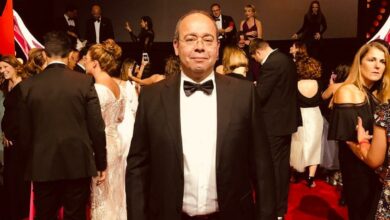Before the launch of Egypt's first magazine dedicated to comic book art for grown-ups, even cartoonists who were not involved in the issue were receiving phone calls of congratulation. Such was the stir caused by the arrival of Tok Tok–and half an hour before the door of the Townhouse gallery's factory space opened for the launch on Sunday night, eager fans and television crews began to arrive.
Founded by five young professional graphic artists, Shennawy, Makhlouf, Andeel, Hicham Rahmah and Tawfik, the quarterly review was welcomed even before anyone had seen it as an important milestone for contemporary Egyptian visual culture.
Although the region has produced momentous examples of mixed words and images, from hieroglyphs through adventure stories such as those collected in “A Thousand and One Nights” to the caricaturists of the Arab renaissance such as Yacob Sanua, the Arab world has produced a relatively small amount of comics.
In Egypt, after the promising success of illustrated children’s magazines in the 1950s, such as Sindbad and Samir, in the 1970s many illustrators and caricaturists started working for magazines in the Gulf and in other foreign countries due to censorship at home.
The magazine Sabah il Khier, where Salah Jahin was once editor-in-chief, stopped hiring young artists in the 1980s. For caricaturists at least, “there was a gap between Sabah il Khier and Al-Dostour,” said Makhlouf, referring to the opposition newspaper whose editor, Ibrahim Eissa, hired young artists and dedicated unusual amounts of space to drawing. Andeel, Makhlouf and Rahmah worked there, and remember being given double spreads to fill with whatever they wanted. (Al-Dostour also printed whole chapters of Egypt’s first graphic novel, Magdy El-Shafee’s “Metro,” in 2005.) A few years ago, the three moved with the caricaturist Amro Selim to Al-Masry Al-Youm.
Selim showed their work to the famous designer, cartoonist and illustrator Mohieddin Ellabbad, co-founder of Tosh Fish magazine, who became a mentor to Tok Tok’s founders until he died last year.
“It is the perfect time for the magazine,” said Makhlouf, pointing out that the five founders’ skills matured for around ten years in their respective professional fields. Andeel is a scriptwriter and newspaper caricaturist, Tawfik a children’s book illustrator, and Hicham Rahmah an animator, caricaturist and illustrator. Makhlouf says his ten years in newspapers has been a “tough exercise,” always working quickly, and always for a grown-up audience.
Shennawy, who Andeel says “orchestrated the whole thing,” is not connected to newspapers, but has a background in graphic and product design as well as drawing.
There is a strong scene of young graphic artists, but initiatives beyond workshops never got off the ground until now. “The difference is we decided to make a product,” said Andeel, “not make work that was too personal or intellectual to easily fit the audience.”
The magazine will contain editorials as well as comic strips and stories. This issue contains an article on 1960s illustrator and cartoonist Hegazi, by Shennawy and Makhlouf. “We wanted to have something that shows what came before, that Tok Tok didn’t come out of nothing,” said Shennawy, acknowledging a debt to the “really well-structured” work of older generations.
The magazine has been a year in the planning and is completely self-funded. According to Shennawy, they wanted to have a complete product to show people before considering finding support. By operating independently they also have absolute control over content.
“Once we believed in Tok Tok and in each other there was a freedom that was like working by yourself,” said Makhlouf.
The first issue of Tok Tok is a slim 44 pages and designed with meticulous attention to detail. The cover features a policeman writing a fine (from a Shennawy story), a choice which in retrospect Makhlouf suggests proves the ubiquity of the government, but which Shennawy sees as representing Tok Tok itself, ticking off the people.
There’s a satisfyingly wide diversity of drawing, from the grubby, atmospheric feel of Shennawy’s work, which seems perfectly suited to depicting Cairene streets, to the hard, patterned lines of Rahmah. Makhlouf’s frames are full of movement to the point of almost vibrating. Andeel likens Makhlouf’s style to traditional Egyptian paintings left on the houses of those on pilgrimage.
Tawfik’s style is minimal in one story and agonized in another, while Swiss artist Katharina Kreil’s is sympathetic and exploratory. Khaled Abdel Azeez’s slick draftsmanship softens a brutal account of military service, and Mona Sonbol’s distinctively solid, painterly style deals with the frustrations of traffic. Rahmah’s cinematic interpretation of the Ibrahim Aslan story “White and Black” poignantly sets death and mourning against a wide-angle backdrop of mundane routine.
“Superhero culture is foreign,” Andeel said. Tok Tok’s focus on the everyday embraces what comics do best and what gives the medium its subversive political power: mixing the high and the lowbrow without sentimentality or propaganda, and carrying a huge potential for ambiguity.
It also makes the magazine undeniably Egyptian, whether in its dealings with sex, traffic or great works of literature. Among the narratives is a spread of funny satirical advertisements and altered logos, and a “Made in Egypt” series inside the back cover, which will select one stereotypical Egyptian character each issue for a drawing and witty biography.
Wassim Maouad, a Lebanese contributor, said, “The last couple of years have seen unprecedented activity in Arab comics. What consisted in the past of political satire, caricatures published in newspapers, and children’s comics is ‘growing up.’ Adult comics can now be published in dedicated magazines like Samandal or La Furie in Beirut, and Tok Tok in Cairo.”
The initial print run of 500 sold out in two hours, at LE5 each, demonstrating Maouad’s statement that the Arabic-speaking world of comics has a “starving audience.” Shennawy says a reprint is underway and Issue 0 of the quarterly magazine will be available at Cairo’s big bookshops next week. He’s interested in creating a focus for discussion, and wants to hold follow-up events in Cairo and Alexandria to spread the word. There have also been discussions with Samandal about putting on a joint event. From the response so far, it seems that people here are ready to take comic books seriously.




